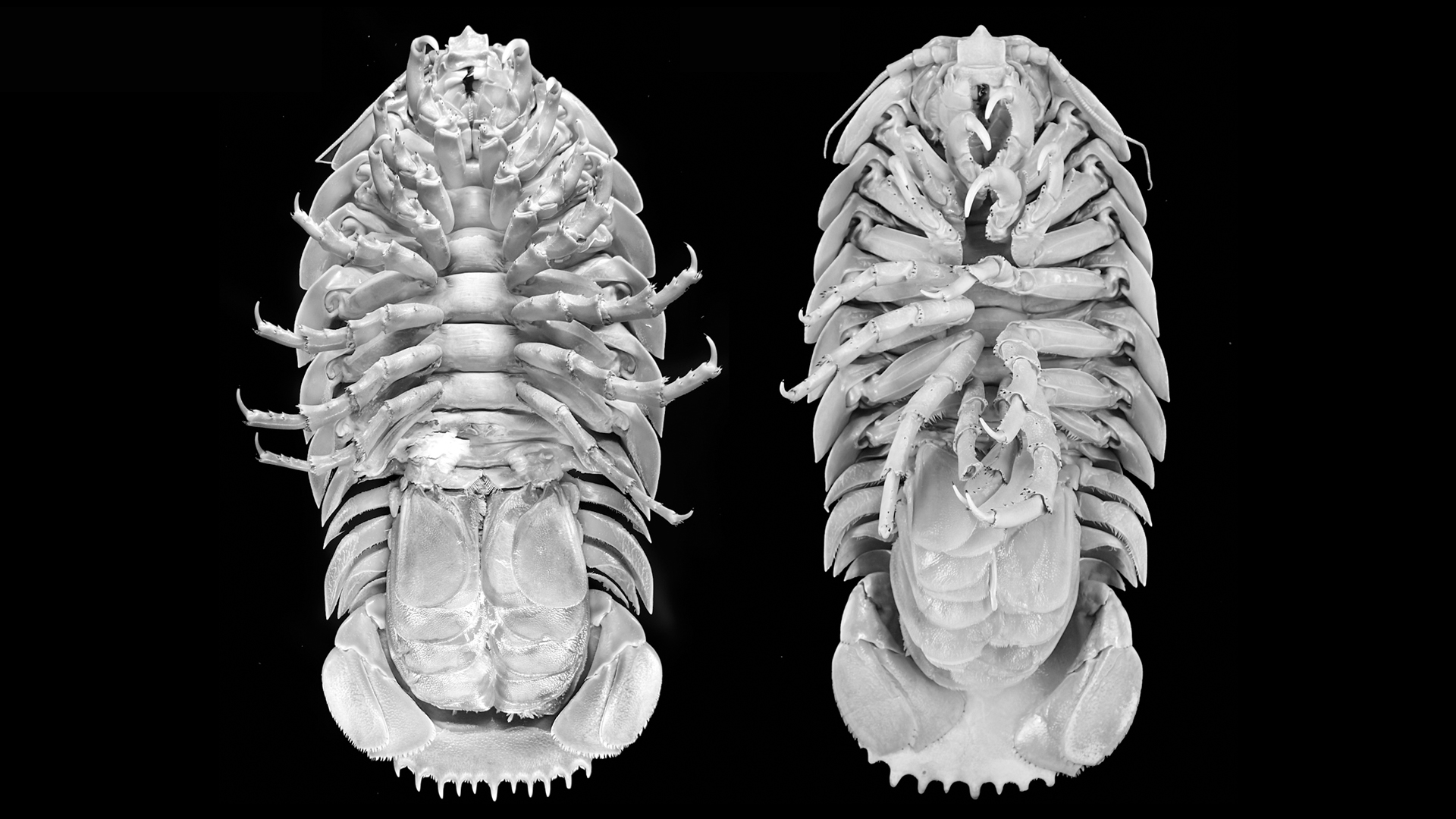Massive 'Darth Vader' sea bug pulled from waters near Indonesia
The newly described species is one of the biggest isopods known to science.

Buglike marine creatures that skitter across the sea bottom can grow to be as big as puppies, and a newly described species is one of the largest ever seen.
These crustaceans are known as isopods; the order Isopoda includes around 10,000 species that live in diverse habitats on land and in the ocean, and they can range in size from just a few millimeters to nearly 20 inches (500 mm) long. Of the ocean-dwelling isopods, the genus Bathynomus contains the biggest species; the newfound isopod, which turned up in the Indian Ocean in 2018, is among the largest of the Bathynomus species ever seen in the wild.
Named Bathynomus raksasa ("rakasa" is the Indonesian word for "giant"), the sizable sea bug measures about 13 inches (330 mm) in length, on average. It is the first new giant isopod species to be described in more than a decade, and is the first of these isopod behemoths to be found in waters near Indonesia, scientists reported in a new study.
Related: Marine marvels: Spectacular photos of sea creatures
Big or small, all isopods share many features, such as four sets of jaws, compound eyes, two sets of antennae, and a segmented body with seven sections, each with its own pair of legs, according to the National Oceanic and Atmospheric Administration.
Of the 16 previously described Bathynomus species, seven are considered to be "supergiants" — maturing at more than 6 inches (150 mm) long and then growing to be 12 inches (300 mm) or more, according to the study, published online July 8 in the journal ZooKeys.

Researchers identified B. rakasa during the South Java Deep Sea Biodiversity Expedition; they collected two specimens, a male and a female, off the southern coast of Java, at ocean depths between 3,117 and 4,134 feet (950 and 1,260 meters). The unique shape of B. rakasa's head shield and abdominal segments, as well as the large number of spines — 11 to 13 — on its abdomen, indicated the supergiant is a new species, the scientists wrote in the study.
Sign up for the Live Science daily newsletter now
Get the world’s most fascinating discoveries delivered straight to your inbox.
During the 2018 expedition, scientists were excited to discover the deep-sea Bathynomus isopods, a genus sometimes "affectionately" referred to as "Darth Vader of the Seas" (perhaps for their heads that resemble the Sith Lord's helmet), according to the Lee Kong Chian Natural History Museum's website. Museum collections specialist and expedition member Muhammad Dzaki Bin Safaruan held up a giant isopod while onboard the Indonesian research vessel Baruna Jaya VIII, in a photo shared by the museum on Instagram that year. "The staff on our expedition team could not contain their excitement when they finally saw one," museum representatives wrote in the post.
A photo posted by @lkcnhm on Apr 1, 2018 at 9:30pm PDT
"The identification of this new species is an indication of just how little we know about the oceans," said study co-author Helen Wong, a researcher with St. John’s Island National Marine Laboratory, part of the Tropical Marine Science Institute at the National University of Singapore.
"There is certainly more for us to explore in terms of biodiversity in the deep sea of our region," Wong said in a statement.
Another team of scientists in 2019 captured rare — and gruesome — evidence of deep-sea isopod behavior, Live Science previously reported. Underwater video showed a group of these giant sea bugs as they ripped apart and feasted on the corpse of an alligator, which the researchers had submerged in the Gulf of Mexico to observe how bottom dwellers might consume this windfall of a meal.
Giant marine bugs that gorge on alligator carcasses may sound unsettling, but massive isopods' much-smaller cousins are arguably even more terrifying. Parasitic isopods known as tongue biters or tongue-eating louses devour fishes' tongues by siphoning off the tongue's blood supply as the organ slowly withers; the parasites then take the tongue's place in a still-living host's mouth.
Originally published on Live Science.

Mindy Weisberger is an editor at Scholastic and a former Live Science channel editor and senior writer. She has reported on general science, covering climate change, paleontology, biology and space. Mindy studied film at Columbia University; prior to Live Science she produced, wrote and directed media for the American Museum of Natural History in New York City. Her videos about dinosaurs, astrophysics, biodiversity and evolution appear in museums and science centers worldwide, earning awards such as the CINE Golden Eagle and the Communicator Award of Excellence. Her writing has also appeared in Scientific American, The Washington Post and How It Works Magazine. Her book "Rise of the Zombie Bugs: The Surprising Science of Parasitic Mind Control" will be published in spring 2025 by Johns Hopkins University Press.










